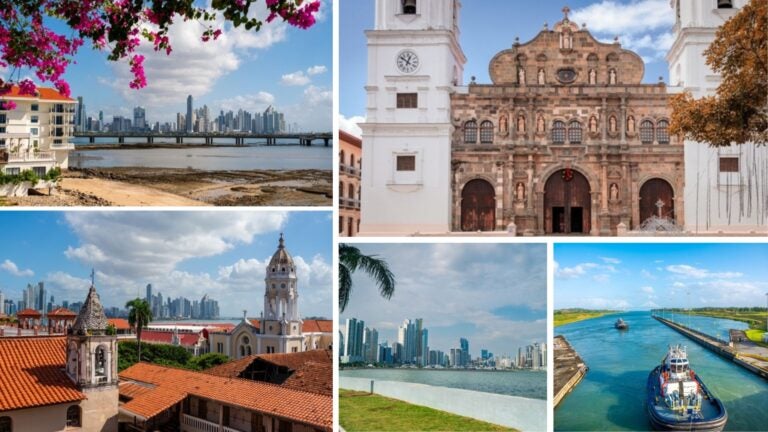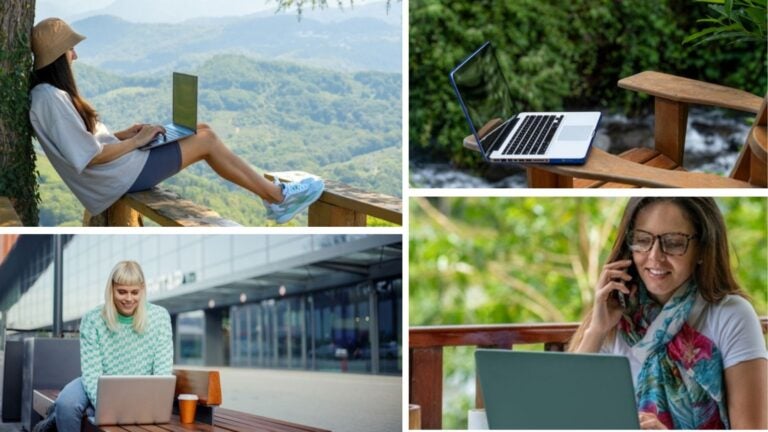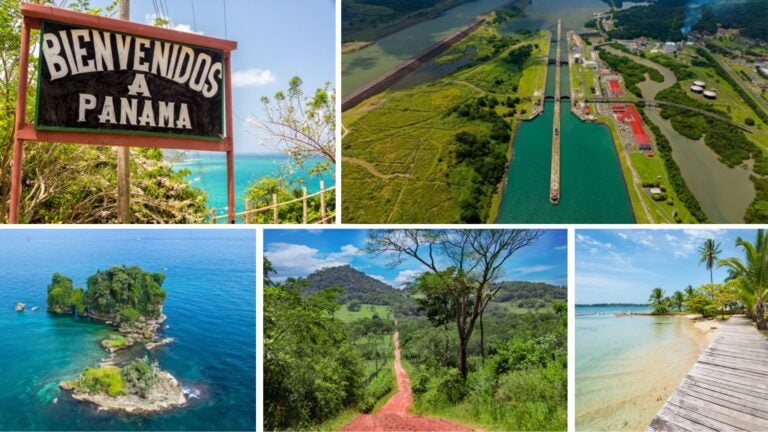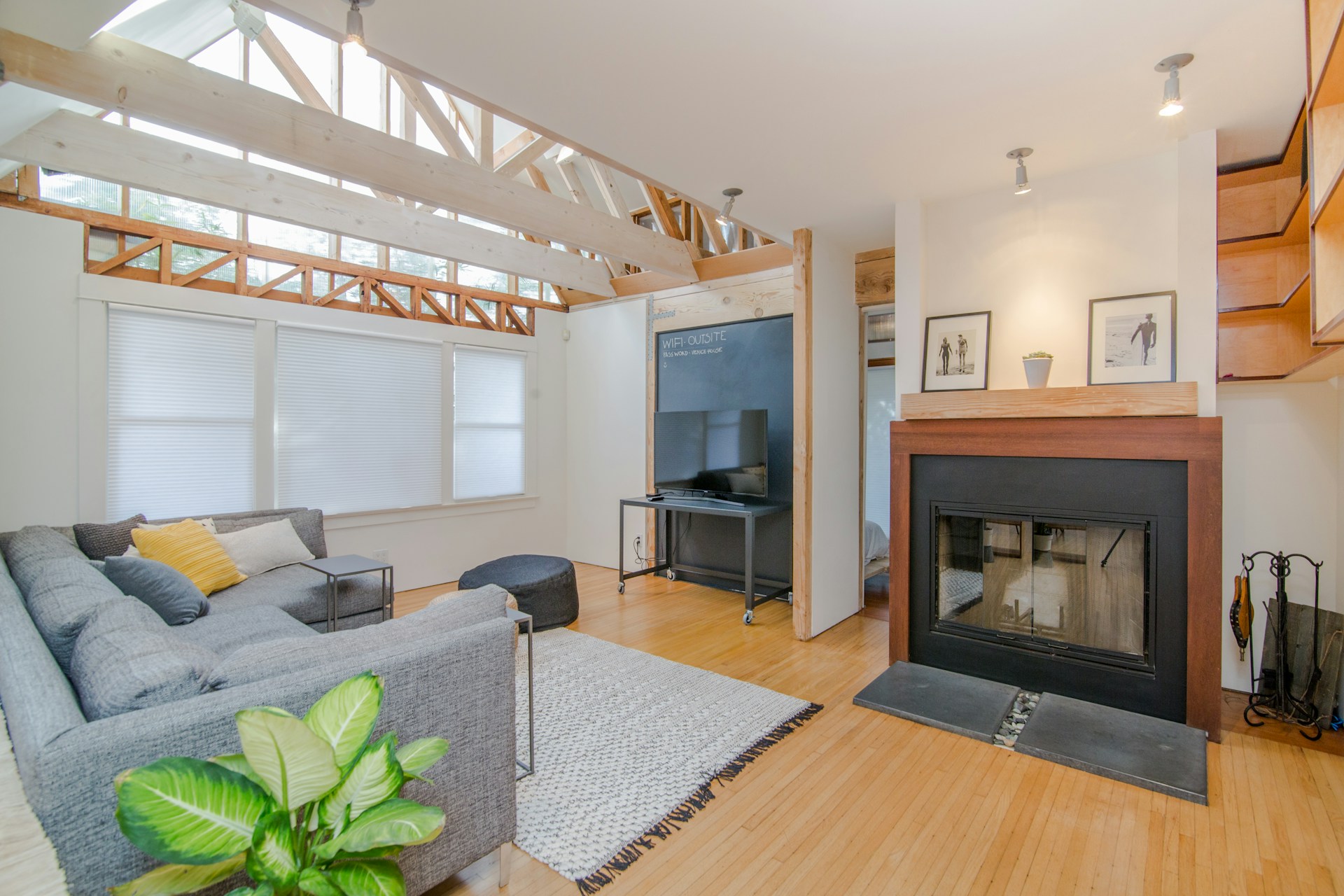Live in Panama: Learn advantages, disadvantages, and costs
We analyze what it's like to live in Panama, what quality of life it offers and the advantages and challenges involved in moving here.
Panama isn’t just about its famous canal. Over the past few years, it’s turned into a popular spot for expats, retirees, digital nomads, and entrepreneurs looking for a budget-friendly place with warm weather, reliable internet, and a growing economy. If you live in Panama you’ll have ocean views in the morning, a dynamic city vibe, a mix of cultures, and modern conveniences. All without the hefty price tag of a big European capital.
Wondering how easy it is to adjust? What the healthcare system looks like? How much rent costs in the capital? Or what job options foreigners have? We’ll break it all down for you. Whether you’re in Panama for a short stay or planning to settle down, we want to help make your experience a great one.
Did you know Panama City is home to over 120 international banks and that the country doesn’t have a winter season? Keep reading to find out if this blend of tropical modern life and Latin tradition is just what you need to make the big move to Panama.
What is the quality of life like in Panama?
Panama stands out as one of the most stable and vibrant countries in Latin America. With a dollar-based economy, warm weather year-round, and a growing international community, it’s a top choice for anyone looking for a tropical city with solid infrastructure and that lively Latin vibe.
If you ask an expat why they picked Panama, chances are they’ll say it’s because of the great quality of life. With modern infrastructure, excellent healthcare, attractive education options, and housing for all budgets, it’s easy to see why. You can dive into the vibrant city life of the capital or enjoy a more relaxed pace in towns like Boquete or Coronado. Ultimately, it’s about knowing what you want and finding your perfect place in Panama.
Having said that, let’s review the key aspects that define quality of life in Panama.
1- Education in Panama
In Panama, you’ll find a mix of public, private, and bilingual schools, with plenty of choices in the capital and good options in other regions too.
Public education in Panama is free but often falls short in terms of facilities and teaching quality. That’s why most expat families choose private or international schools, especially if they want a multicultural environment or programs that follow foreign curricula like the IB or the American system.
Are you moving to Panama with your children? Here is a breakdown of the estimated costs of Panamanian schools:
- Public schools: Free of charge, but you pay for the uniform, school supplies and some administrative fees.
- Private bilingual schools: Between $2,000 and $8,000 per year, depending on the level, location and prestige.
- International schools (IB or American): From $10,000 to $18,000 per year, especially in areas such as East Coast, Clayton or San Francisco.
At the higher education level, Panama has both public and private institutions, some with a strong reputation. The University of Panama is the largest public university, while schools like USMA and UTP offer programs in tech, business, and more. You’ll also find international options, like Florida State University’s campus right in Panama City.
2- Cost of living
Living costs in Panama can vary a lot depending on where you are. Panama City tends to be the priciest, especially in upscale neighborhoods like Punta Pacífica, Costa del Este, or San Francisco. But if you choose more modest areas or live outside the city, prices drop quite a bit.
For example, renting a furnished one-bedroom apartment in the pricier parts of Panama City can cost anywhere from $850 to $1,200 a month. But if you look outside the city, you might find similar places for as low as $400. El Cangrejo is a great neighborhood that offers good value and a lively atmosphere. Plus, there are coliving spots like Studio Coliving that cater to nomads and remote workers, providing affordable places to live and work.
What about other expenses? Groceries, for example, usually run around $100 to $150 a month per person. In Panama City, to get the best deals, it’s smart to shop at places like El Rey supermarket or the local seafood and fresh produce markets.
Add to that the cost of utilities like electricity, water, and internet ($120 and $180) and transportation expenses such as Uber, gas, or buses ($50 to $100). If you include private health insurance starting at about $40 a month, your total monthly budget in Panama City could range from roughly $1,100 to $1,800, depending on where you live and your lifestyle.
However, in smaller cities or towns such as Boquete, Coronado or El Valle, these costs can be 20 to 40% lower.

3- Security and community living
Panama is among the safer spots in Central America, but safety depends on where you are. Areas like the residential, diplomatic, and tourist districts in Panama City tend to be quite secure, thanks to visible police and private guards. Still, just like in many big Latin American cities, some neighborhoods call for extra caution.
The safest neighborhoods for expats are usually Costa del Este, Clayton, Punta Pacífica, San Francisco, and Albrook. These areas tend to have a friendly vibe, and locals are generally welcoming. On the flip side, El Chorrillo is known as one of the more dangerous parts of the city, so it’s best to avoid. At the end of the day, picking the right neighborhood is key.
Outside Panama City, safety remains solid in many spots, especially where international communities have settled. Boquete, up in the mountains of Chiriquí, is a favorite among retirees and expats thanks to its cool climate, peaceful vibe, and great quality of life. Coronado, down on the Pacific coast, attracts those wanting a relaxed beach lifestyle with plenty of summer homes and foreign residents. For those who prefer quieter, nature-filled places away from the tourist hustle, Volcán and Tierras Altas offer a calm atmosphere.
Basically, while there are some remote parts of the country where services aren’t great and it’s wise to stay alert (like in Colón or Darién) most neighborhoods popular with expats are pretty safe and quiet. Like anywhere, the best advice is to do your research beforehand to avoid any issues when settling in.
4- Labor market and wages
Panama’s economy is on the rise, backed by a strong financial system and a hub for many multinational companies, especially in Panama City. This creates job opportunities in fields like logistics, finance, construction, tech, international trade, and education.
Wages in Panama vary by industry, with minimum pay usually around $400 to $700 a month. Skilled professionals, though, can expect better pay, especially in sought-after fields or with international firms. Marketing and admin roles typically bring in between $1,200 and $2,000, while jobs in engineering or logistics can go up to about $3,000 monthly. Bilingual teachers are also in demand, earning roughly $1,000 to $1,800 a month.
Keep in mind that working legally in Panama requires a work permit, which you can apply for once you have the right residency or visa. If you’re a digital nomad, there’s a special visa under the ‘Short Stay Visa for Remote Workers’ program that lets you stay up to 18 months while working remotely for foreign companies.

5- Health system in Panama
Panama’s healthcare system is a mix of public and private services. The public side, managed by the Social Security Fund (CSS), is available to all residents but can involve long wait times and uneven quality. That’s why many expats choose to go to private clinics and hospitals.
The good news is that Panama boasts top-notch hospitals like Punta Pacifica Hospital (affiliated with Johns Hopkins), Hospital Nacional, and Paitilla Medical Center. These facilities have doctors trained abroad and often provide services in English.
That said, if you don’t have health insurance, medical expenses can add up quickly. A general doctor’s visit might cost around $60, and a night in the hospital can range from $500 to $1,500. For this reason, most expats choose to get health or travel insurance (like SURA) to cover doctor visits, emergencies, and even repatriation if needed.
6- Lifestyle and healthy habits
Life in Panama is laid-back, friendly, and warm. Despite the heat, many locals like to exercise early in the morning or around sunset. They enjoy the city’s green spaces, like Parque Omar and Cinta Costera, and have easy access to fresh fruit, seafood, and traditional dishes like ceviche, coconut rice, and tropical salads.
Life in the city can be fast-paced, but many expats in Panama appreciate the balance between work and leisure. With the beach, mountains, and jungle all less than two hours from the capital, it’s easy to take quick getaways and reconnect with nature.
7- Internet connectivity and digital life
Panama stands out in the region for its strong internet infrastructure. In the cities, you can expect solid coverage, with most places having fiber optic connections and fast speeds around 100 Mbps. 4G networks are widespread, and some areas in the capital are even starting to get 5G.
If you’re a digital nomad or remote worker, Panama has lots of coworking spots and the digital world is totally part of daily life. You can easily use digital banking, food delivery and ride apps like Uber or DiDi, plus e-wallets and online services for things like visas and finances.
If you want to have internet access as soon as you arrive in Panama—without the hassle of buying a Panama SIM card or signing contracts—Holafly’s monthly plans are a great option. Their unlimited data eSIM lets you instantly use messaging apps, navigation, translation tools, online banking, and video calls, all with no hidden charges. Plus, since it works across multiple countries, you can travel through Central America without changing your plan.
Important: If you are a frequent traveler and want to stay connected without worrying about expensive roaming or looking for a new SIM at every destination, Holafly’s subscription plans are for you. With a single eSIM, enjoy internet in more than 170 countries for a fixed price and no surprises on your bill. Travel without limits and connect easily and securely! 🚀🌍

What are the advantages of living in Panama?
Now, let’s explore what makes living in Panama so appealing. Its strategic location, manageable size for easy travel, and the blend of vibrant cities with laid-back towns, beaches, and mountains create a unique lifestyle. Simply put, Panama has a lot to offer.
1- Tropical climate all year round (no winters)
One of the biggest perks of living in Panama is saying goodbye to the cold (unless you’re a snow lover, in which case you might want to reconsider your destination). Temperatures hover comfortably between 24 °C and 32 °C all year long. Although there’s a rainy season and a dry season, you can forget about shoveling snow or packing bulky winter clothes.
This makes daily life easier and lets you enjoy outdoor activities year-round, whether you’re in the city or out in nature. Plus, one of the biggest benefits is that you save money on heating, winter clothes, and seasonal home upkeep.
2- A country where nature is within reach
Panama may be small, but its natural beauty is huge. You’ve got lush mountains, beaches on two oceans, tropical jungles, rivers, hidden waterfalls, and stunning islands. So, one moment you could be in a meeting, and just a few hours later, you’re swimming in the Caribbean or hiking in the hills.
Don’t know what to visit in Panama? Here are some recommendations:
- Bocas del Toro Archipelago (Caribbean)
- San Blas and its virgin islands inhabited by indigenous peoples
- Baru Volcano and trails in the Highlands
- Coiba National Park, ideal for diving
- Chagres River, jungles and surrounding villages
Don’t forget about Panama’s famous canal, one of the most impressive engineering feats in the world. Watching the massive ships move through its locks from one ocean to the other is truly unforgettable.

3- Tourist and cultural attractions
Panama is a melting pot of cultures. Indigenous, Afro-Caribbean, European, North American, and Latin American influences all come together in its music, celebrations, architecture, and people. There are places like the Old Quarter, Amador Causeway, the colonial ruins of Panama Viejo, interactive museums like the Biomuseo, and towns like Portobelo and La Villa de Los Santos that keep the country’s most traditional spirit alive.
Festivals mean a lot to the people of Panama. The Las Tablas Carnival stands out as one of the most amazing celebrations around. Throughout the year, there are parades, farmers’ markets, food fairs, and sports events. No matter when you visit, Panama always has something exciting going on!
4- Varied, tasty and accessible gastronomy
Living in Panama is a treat for your taste buds. The local cuisine blends flavors from the Caribbean, the jungle, and the Pacific—think coconut rice, tamales, ceviche, stews, fried plantains, and fresh seafood, just to name a few.
Panama City has a vibrant international food scene. From great sushi and Peruvian dishes to Italian, Lebanese, and Mexican flavors. You’ll find everything, from organic cafés to French bakeries and authentic ramen.
What’s great is how affordable it is. You can enjoy a full meal for just $4–5. And if you prefer cooking, the markets offer plenty of fresh, budget-friendly tropical ingredients.
5- Friendly treatment and relaxed atmosphere
Panamanians are generally warm, laid-back, and welcoming. If you speak Spanish, fitting in socially is easy and even if you don’t, there’s always someone willing to lend a hand. Expats from all over the world call Panama home, creating a friendly, diverse atmosphere.
Compared to places like Bogotá or Mexico City, life in Panama is more laid-back. Sure, the capital has its hustle and traffic, but overall, things run on a more flexible, go-with-the-flow vibe. If you’re used to a high-pressure or super-structured lifestyle, it can feel refreshing.
6- Stable, dollarized economy
With the U.S. dollar as its official currency, there’s no worry about sudden devaluations, and it makes saving or investing easier. Add to that a solid international banking system, low inflation, and a business-friendly environment, and you’ve got a strong foundation for both stability and opportunity.
Panama is one of the most welcoming countries in Latin America for foreign investors and professionals. It offers tax breaks, free trade zones, and immigration programs designed to attract global talent. Whether you’re planning to start your own business, work remotely, or invest in real estate, you’ll find a stable, reliable economic environment ready to support you.
What are the challenges of living in Panama?
While Panama has a lot going for it, there are also some challenges to consider before making the move. From the tropical weather to gaps in public services and the occasional day-to-day frustration, some aspects might be an adjustment.
Below, we review the main issues of living in Panama, so that you can clearly evaluate the pros and cons of the country.
1- High cost in exclusive areas
Panama can be affordable, but if you’re eyeing modern neighborhoods like Costa del Este, Punta Pacífica, or San Francisco, be ready for high prices. Rents and everyday costs can rival those in major global cities. You can cut costs by living in more traditional areas, but don’t expect Panama City to be a budget destination.
2- Limited public transportation and heavy traffic
Public transportation doesn’t cover the whole city very well, and options outside the capital are even more limited. The metro runs smoothly but has just a few lines. Because of this, many people rely on cars, which leads to heavy traffic and long commutes.
3- Humid and rainy climate
The warm weather might seem like a plus, but the humidity and daily rains during the wet season (May to November) can get pretty uncomfortable. Tropical storms are common, and it often feels hot even after the sun goes down. In some areas, the dampness can take a toll on clothes, furniture, and even your respiratory health.
4- Inequality and marked social contrasts
Like many places in Latin America, Panama has a sharp divide between wealthy neighborhoods and areas where basic needs aren’t fully met. In the capital, you can go from luxury high-rises to vulnerable communities just a few blocks away. While it’s not usually a direct safety risk, it can affect how safe people feel and their day-to-day experience.
All things considered, living in Panama can really boost your quality of life if you’re looking for warm weather, economic opportunities, close access to nature, and a growing international vibe. With a stable economy, easy options for foreigners to settle in, and the chance to enjoy the beach, jungle, and city all in one day, Panama stands out as a truly unique spot in the region.
It’s not perfect, though. Living in fancy neighborhoods can get expensive, and the traffic and humidity might catch you off guard. Still, if you stay flexible and open-minded, Panama can offer a modern, balanced life with lots of opportunities to thrive.
Frequently asked questions living in Panama
Panama is a solid choice for remote workers and digital nomads. The internet’s reliable, the time zones work well with both the Americas and Europe, and the tax setup is pretty attractive. Plus, they offer special visas for nomads, and the capital is full of coworking and coliving spots.
How much you’ll spend depends a lot on your lifestyle and where you live. That said, a single person can comfortably live on about $1,100 to $1,800 a month in Panama City. Costs drop quite a bit if you move to smaller towns or places like Boquete.
Most services are centered in Panama City, but if you want something more laid-back, places like Boquete (mountains and cool weather), Coronado (beach and expat vibes), or El Valle de Antón (nature and fresh air) are great options. It really depends on your lifestyle and what you’re after.
You don’t have to speak Spanish, but it definitely helps. In Panama City and tourist areas, many people speak English, but knowing Spanish makes daily tasks easier and helps you truly connect with the community.
Yes, foreigners can buy property in Panama without being residents, except in border areas. The process is straightforward, and there’s a good range of options whether you’re looking to live there or invest.





 Language
Language 


















 No results found
No results found








